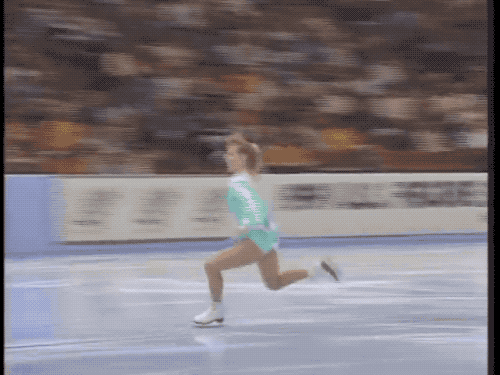The Wildness of Tonya Harding’s First Triple Axel on Live Television
Figure skating is a sport full of dichotomies: strength–grace, athleticism–artistry, male–female, objectivity–subjectivity.1 Its dominant movement aesthetic is derived predominantly from the western dance realm: ballet (to a high degree), jazz dance, modern dance, contemporary dance and popular dance forms. Frequently shown on television, one can view it through a lens of popular dance on screen, which, according to Sherrill Dodds, aesthetically values the dance as spectacle beholding an idealised body.2 The GIF accompanying this essay depicts the first time an American female figure skater, Tonya Harding, landed a triple axel in a major competition at the 1991 US National Championship in Minneapolis, Minnesota. A rarity in skating still today, this extremely difficult jump involves a forward take-off turning 3.5 times in the air and landing backward on one foot. It was broadcasted live through ABC's Wide World of Sports with two Olympic champions Dick Button and Peggy Fleming and sports reporter Al Michaels commentating. This piece provides an analysis of this jump's "wildness," which enhances the unbridled experience of live television and its subsequent re-watching on YouTube.
In many ways, Harding often adheres to balletic codes – shaped hands, graceful and upright port de bras, arabesques and cambrés – and yet her body and movement often defy it: she has a stocky, muscular frame coupled with athletic, almost superhuman jumps. In this clip, she begins by gaining speed and taking the length of the rink to set up the jump. Harding skates to Danny Elfman's soundtrack from Tim Burton's Batman (1989). The string and horn instruments convey an intensifying momentum and strength evoking a "flying" or "superpower" aesthetic, which complements the feat she is about to perform. The camera moves with her as she steps into the air swinging her right leg, then pulling arms tightly into the chest and squeezing her thighs to complete the 3.5 rotations before landing backwards. Harding's compact body allows her to "spring" attaining great height. Unlike other jumps which take off backwards, the axel requires the skater to quite literally take a leap forward into the unknown from a precarious edge instead of the relative stability of a toe pick.
From a technical standpoint, her jump is not "perfect" because her leftward leaning causes her left leg to swing out. However, this "fault" actually communicates the enormous force, height and distance that this split-second jump produces. This "wild" landing also points to the unbridled, new frontier of women's figure skating in the early 1990s: Harding is a pioneer who has trained her body to perform great athletic feats which female skaters have never been pushed nor expected to do. According to aesthetic codes derived from ballet, women's skating jumps should look effortless and light, putting the crowd at ease. However, Harding's instead place the audience on edge because of the rare triple axel attempt and her almost masculine athleticism. Upon landing, she can hardly believe what she has done conveying her raw and "wild" excitement by pulling both her arms up with elbows bend toward her head and screaming, thus physically breaking her skating "character" in order to rightfully celebrate her feat. The excessive excitement of this moment relates to Elena Benthaus's term "WOW-affect," which describes a surplus of affective intensities between screen, athletic/virtuosic bodies and audience, which have not yet been cognitively registered.3
The live broadcast also lends a sense of rawness and excitable affect that can lead to wild emotions. While Button and the other commentators have notes from which they will read in order to introduce Harding, the manner in which she skates and the jumps she lands will be analysed on the spot. In contrast to a recorded performance, the liveness, even though mediated, still relays an untamable wave of excitement further unleashing wild affect. Liveness means audiences experience the unscripted emotions of Button as he feels and expresses them verbally. After Harding lands the triple axel, he ecstatically yells, "Good girl! Isn't that great, only Midori Ito has completed a triple axel in competition. Oh, how nice, how terrific!" By outlining the rarity of landing the jump, Button's uncontrollable enthusiasm flows right to the veins of the viewer. Even if watched later on YouTube, reliving the mediated and historical event creates a comparably satisfying spectacle to the live version. For example, having likely watched the clip over and over, Poppy Sinclair, from the YouTube comments on this clip writes: "This gives me literal goosebumps every time she lands the triple."
While I would not say television and its reproducibility necessarily take the place of live performance in Harding's case, it certainly enhances and harnesses emotion differently because of its medial capabilities. The camera focuses more on and can travel with the entire skater's body, evoking a close-up form of meaning-making4 and kinesthetic empathy. The televised mediation includes the power of her facial expression through close-ups and during personal interviews. One evocative sequence in particular occurs after her performance when she sits and receives her marks, which include a perfect score of 6.0 that sends her and the crowd into a euphoric state. In fact, its mediatedness adds an even greater layer of intensity because of the commentators' emotional verbal expression and the strategic shots of the camera: shooting audience members clap, cheer, and slowly rise as Harding finishes her final spin. The unbridled force of Harding's triple axel combined with the liveness of her performance and Button's affective commentary ignite the viewer allowing for an overflowing of wild emotion.

